Orlando Brown film review: Do the Chiefs have their left tackle?
Looking at every snap over 8 games throughout the 2021 season to see how Brown performed in a very different environment.
With news that Orlando Brown is being franchise tagged by the Chiefs, I’ve decided to make this post unlocked for all so everyone can see why the Chiefs view keeping Brown in Kansas City as crucial. If you enjoy going beyond the box score here, you should consider subscribing for content like this every week for $12 a year, or the price of a footlong sub.
The moment the Chiefs gave up the equivalent of a first round pick for a Orlando Brown Jr., they were making a statement as to how they viewed him. One doesn’t give up that sort of draft capital for a one-year mercenary, even if doing so means getting him at a relative bargain price for that year (Brown’s cap hit last year was 3.4 million dollars). We all know this intuitively.
Because of the price that was paid for him and the questions about his fit in Kansas City’s system (a 6’8, 345-pound tackle who relies on power is a vast change from previous left tackle Eric Fisher), Brown had more eyes on him this year than any Chief not named Patrick Mahomes. The Chiefs made a significant investment, and with Brown’s contract up after the 2021 season Kansas City now has a choice in front of it; Will they attempt to re-sign Brown (which will be pricey, that’s just the fact of starting left tackles) as was the clear initial plan, use the franchise tag to see how another season in the system goes, or let him walk in free agency?
The final optionis one that’s highly unlikely given Kansas City’s investment in Brown and the importance of the left tackle position. That said, the answer to what the right choice with Brown is lies in the film. How did Brown perform his first season with the Chiefs? When I reviewed Brown’s film from Baltimore, one thing that stood out immediately was how different his role would be in Kansas City, in a very different offense.

The Ravens didn’t ask Brown to take vertical sets or pass protect on an island remotely as often as the Chiefs did, and there was always a question as to how Brown would respond. And as the year went along, I had plenty of people tell me they were disappointed in Brown’s performance or viewed him as a liability in pass protection.
As ever, the only way to get the answers that we’re looking for is to look at every snap. For offensive linemen in particular, it’s easy to get caught up on one or two plays when there are 50-70 total snaps that comprise their body of work each week. And make no mistake, what’s happening on a snap by snap basis is far more important than how good (or bad) a single rep looks.
And so I charted 8 weeks of Orlando Brown’s 2021 season: CLE, BAL, TEN, GB, DAL, LV, BUF (playoffs), and CIN (playoffs). I tried to span the entire year so I could get an idea as to how Brown developed and adapted to his new surroundings, and I tried to look at games where I thought on first watch he struggled AND games on first watch he appeared to play well. I additionally wanted to be sure to include games against high-level competition (like Garrett, Parsons, Hendrickson,band to a lesser extent Smith, Campbell, Houston, and Ngakoue).
Those who haven’t read an offensive lineman review here before, here’s a quick primer (the rest of you can skip ahead to the numbers):
I chart every pass blocking and run blocking down for wins, losses, and neutral snaps (“PBW” = pass block win, “PBL” = pass block loss, and the same with run blocking), as well as for pressures/hits/sacks allowed on the quarterback. A win is a snap in which the lineman executes an excellent 1x1 block or a great combo block (starting with a double team then getting into space alone). A loss is when a blocker gets beaten or misses a block. A neutral snap is when the blocker might give ground but fights the defender to a draw, or has little to do on the snap.
It’s worth noting that losses are far, far more important than wins for offensive linemen, as in general a dominant block doesn’t guarantee that a play succeeds but losing on a snap can doom a play to failure. So a player having a high win percentage matters a lot less than a low loss percentage, and “neutral” snaps are still a victory of sorts (especially against elite competition).
With that primer in mind, let’s talk about how Orlando Brown performed in 2021.
Let’s start with the numbers and work our way forward from there.
All right, so that’s a lot of numbers over the course of 8 games. What do they mean?
Well, if we’re going to be comparing Brown to Eric Fisher, it makes sense to link to the last time I reviewed Fisher’s film in-depth. This was following the 2017 season, one of Fisher’s better years. Fisher’s win percentage was almost identical to Brown’s, but his loss percentage was 9.4% to Brown’s 7.5%. Take from that what you will, but it’s at least worth noting that in a system that was more controlled (Alex Smith’s final year) and one that he’d been in for 5 years, Fisher performed at a relatively similar level to Brown in terms of win/loss percentage, with Brown being superior in loss percentage.
What I found relevant about Brown was the fact that he managed to go all 8 games without a loss percentage of over 10% (which is where I draw the line towards what is needed from a starter), despite facing multiple high-quality pass rushers. His performances against Garrett and Hendrickson in particular caught my eye in terms of percentage of snaps he was able to render them non-factors (though they each got him once on a sack). That’s positive news for Brown in terms of consistency, something that Fisher struggled with against top-tier opponents. We’ll circle back to this later.
A second thing I noted was that despite Brown’s low loss percentage, his pressure/hit/sack stat is not in a place I want it to be. He gave up 5 sacks in 8 games (with 2 sacks against the Titans being a big part of that), and his hit/pressure numbers are a bit higher than I’d like as well. What do we take from that? We’ll go into more detail in the "where he needs to improve” portion, but the short answer is that when Brown does lose, it can be an ugly loss and more likely to lead to a pressure/hit/sack.
Despite that, Brown’s consistency at tackle and his improvement in loss percentage as the year progressed (outside his Week 2 performance, which I partly chalk up to good matchups for him) are encouraging. Let’s talk about how he got there.
(NOTE- the clips here are intended to be DEMONSTRATIVE, not DISPOSITIVE. What I mean by that is the clips are meant as examples of what showed up on tape consistently, not as “proof” of anything. Any NFL player will have good clips and bad clips. What’s important is what he does snap in and snap out)
What Brown does well
If I were to sum up Brown’s greatest strength as a player, it’s his ability to turn every single pass rusher he faces into essentially the same guy. That is, his traits and skillset make him nearly impossible for defenders to beat any way other than around the edge. When they try anything else, it goes poorly for them. One could really do a “you’re gonna have a bad time” instructional video on Brown when it comes to trying stuff other than the edge on him. As in, if you try to beat him inside, you’re gonna have a bad time.
When defenders attempt to move inside on Brown, he consistently (especially as the year went along) shows solid feet to slide inside and utilizes his almost unreal length and unusual upper body strength to either direct them around the pocket or send them sprawling. This is consistent regardless of opponent. Garrett, Hendrickson, Parsons… none of them had much luck trying any sort of inside move.
This is in part a testament to Brown’s unique traits as a player. There just aren’t that many 6’8”, 340-ish pound players with long arms and strength to match in those arms. But it’s also a testament to the fact that he’s worked at opening his hips and moving laterally when defenders try to beat him inside. It’s not impossible, but it’s a losing proposition the vast majority of the time.
To continue this train of thought, if you try to go through Brown with a bull rush or another power move, you’re gonna have a bad time.
This is one of my favorite blocks of the year from any player, and it’s made even better by the fact that it’s against elite competition in Hendrickson, who is an excellent technician. He doesn’t have great length, though, and Brown is able to snatch the back of his helmet and just toss him to the ground. He then finishes… twice. Seriously, this snap is never not funny. Look at this.
Obviously, not all of Brown’s wins against power rushes are this dominant. However, it’s demonstrative of the problem he gives defenders if they want to try to go through him. Brown’s superior length and upper body strength allows him to either snatch and trap rushers or stand is ground even if his feet aren’t where he needs them to start the snap. He’s one of few offensive linemen who can let a defender get inside his pads but still stand firm with pure power while he resets his feet.
This snap doesn’t look like much, but that’s the point. Preston Smith is a good pass rusher whose power gives a lot of tackles issues. His long arm move usually gets leverage on opponents and lets him either walk them back into the quarterback’s lap or puts him in a position to throw them aside while he moves inside.
On this snap, none of that happens. Despite the fact that he’s able to get hands on Brown first, his usual “pop” is more of a… well, nothing. Brown gets jarred back perhaps half a yard to a yard but is strong enough to hold steady before he can get his feet back under him. Even when Smith gets his feet planted for a big shove, it doesn’t move Brown’s whole body the way it should. There’s just no real movement here on a good power move from a very powerful player.
And when defenders let Brown beat them to the spot or get a punch them… well, they’re gonna have a bad time.
If it seems like there’s a pattern here, there is. If you’re square with Brown, you’re in trouble. If you try to move inside on Brown, you’re in trouble. It’s virtually universal across the board, regardless of the talent, power, or technical ability of the opponent. Brown’s dominant physical traits (and his knowledge of how to use them) give him a consistent edge inside or straight ahead.
Because of that, every pass rusher who faces Brown ends up coming to the same conclusion; They have to try to win the edge. It’s the only place opponents found any sort of consistent success with him. We’ll get into how they did that in the “where he can improve” section, but it’s worth noting that Brown improved in protecting the edge as the year progressed. It appeared that he was placing an emphasis on getting a good jump at the line (I lost count of the number of near false starts he had over the latter half of the season) to counter opponents testing the edge over and over.
Brown was able to make opponents predictable by forcing them to try the edge time after time. He’d then chase them up the arc and force them around the pocket. Because of his lack of footspeed, these wins often didn’t look pretty, as he’d be stuck chasing rather than sliding. But that didn’t make it less effective the majority of the time.
This is a good example of the way Brown would often win ugly, as well as how Mahomes adjusted to the way Brown can win as the year went along. Brown starts off the snap with a horizontal set and is looking to get hands on Hendrickson, who does a nice job widening his arc a bit to prevent Brown’s left hand from touching him. At this point, Brown has to HUSTLE to chase him to the top of the arc and it’s a race to stop Hendrickson from bending towards Mahomes.
Brown doesn’t exactly win the race to the top, but he does get close enough that those arms are able to extend and shove Hendrickson and force him to loop harmlessly around the pocket. A key here is movement from Mahomes, who trusts his interior to win and takes a step up after hitting the top of his drop. This rhythm between the two of them got better as the year went along, and it’s part of why (I believe) the fanbase’s perception of Brown started to shift. It’s very different from what we used to see from Fisher, who never struggled to catch defenders at the top of the arc but could be beaten by power and inside moves. And so Mahomes had to adapt to how Brown can render defenders ineffective.
The thing about these snaps, though, is that they’re somewhat ugly. It’s not a “fresh kick-slide” that people love to see with tackles. It looks lumbering and desperate, even if it’s not. And another thing to note is that Brown is often able to direct edge rushers wide even when he loses that race to the edge thanks to his length. And while those snaps look even uglier, they’re neutral at worst and allow the pocket to function appropriately. The problem that occurred early in the year was that Mahomes’ tendency to drift back and/or bail right (a habit he picked up with Fisher/Schwartz) made these snaps look much worse than they were.
This isn’t a great snap for Brown, but it’s not remotely as bad as the result (a sack). He’s facing a good edge rusher in Dupree who has some burst, and Dupree is able to swipe and corner decently. However, it’s the movement from Mahomes that really differentiates this snap from the one above against Hendrickson. As he drops back he drifts to his right and doesn’t adjust by stepping up. This is, again, a habit he likely picked up with Schwartz on the right side and the risk of Fisher losing to power on the left side. However, Schwartz isn’t there anymore, and the RT gets walked back into his lap. With a bit of pressure coming from the interior (Smith and Humphrey seem to have a decent handle on it, but it’s there), Mahomes tries to bail right and Dupree is able to run right into him.
It’s hard to do, but picture Mahomes dropping straight back or stepping up here. That would have forced Dupree to try and corner sharper and given Brown an easier angle to shove him wide. Additionally, it would have led to Mahomes having an open B-gap to escape through from any other pressure once Brown forced Dupree around the arc. That’s what we started to see more and more as the year progressed and Mahomes/Brown grew comfortable with one another.
If you’ve made it this far, you’re someone who enjoys in-depth content that looks at the “why” and goes farther than the box score. If that’s the case, and you haven’t subscribed, you’re missing out on this type of stuff every single week. You can subscribe for 60% off by clicking the button below. Do it. DO IT.
In terms of the mental side of the game, Brown was consistently comfortable with stunts and other games up front, as well as blitzes. He’s a cerebral player who doesn’t get enough credit for it due to his size/power (similar to Trey Smith), and the times when he missed a looping defender were rare.
The short answer as to Brown’s work as a pass rusher is that he is Fisher’s peer as of now, at least as of his 2021 body of work. What’s more, he’s less susceptible to being beaten/dominated by higher level of competition, which gives him an edge over Fish. He also has a number of dominant snaps in every game when he’s able to beat the defender to the spot and get his hands on first. And due to his unique traits, he’s able to turn pass rushers into one-trick ponies regardless of who they are. Given that it was his first year in Reid’s system and there was improvement as the year went along, there’s a lot to like about what he showed as a pass protector in 2021.
As a run blocker, Brown is an asset as long as he’s in his wheelhouse. He’s a powerful player who can help generate movement at the point of attack in a way Fisher couldn’t consistently do. That’s not surprising given his size. He’s also comfortable taking on linebackers and utilizing his frame at the second level to wall them off or push them out of the play entirely.
Throughout the season, Brown was an asset when the Chiefs tried to run the ball, particularly when being asked to either help form a wall and/or move defenders off the point of attack. He’s smart about how he works at the second level, getting hands on when he can and not grabbing/holding when he can’t. He knows that his mere presence out there on screens or climbs can force defenders out of the play and he doesn’t overextend to get himself in trouble once there.
Brown’s contributions to the run game weren’t limited to pure power. He’s also able to pull across the line. Similar to when he’s asked to climb to the second level, as long as he’s asked to move in a straight line he acquits himself better than one would expect. And when he does so, he consistently wins at the point of attack when he meets whatever defender is unfortunate enough to have to try and hold up against Brown with a head of steam. He also doesn’t get himself in trouble lunging in those situations, knowing he needs to seal things off but doesn’t necessarily need to go pancake hunting.
I could say more about his run blocking here, but it really is pretty simple When it comes to him. Generating push, forming a wall, executing combo blocks where he assists with a double and climbs, and pulling across the line of scrimmage are all areas Brown does at a plus level. That’s more than enough of a skillset for him to be a solid player and execute a variety of different looks from the tackle spot, and he’s part of the reason the Chiefs could punish defenses for light boxes given his ability to wall off or generate push against the vast majority of defenders in 1x1 situations.
Where Brown can improve
This section won’t be as long due to the fact that Brown is a good player, and there are always going to be fewer areas to improve for good players. But it also won’t be as long because Brown’s weakness is evident when watching him; He’s not a quick player and can be caught off balance as he tries to overcompensate for that lack of quickness.
That’s an oversimplification, of course. When Brown gets his feet right he is quicker than he gets credit for. But we’ll get to that in a moment. The first thing to talk about is the edge. Because as much as Brown is an asset in pass protection for his ability to make opponents one-trick ponies, he still loses to that trick a little more often than I’d like.
Obviously, Micah Parsons is an alien, so it’s not ENTIRELY fair to utilize the loan “loss” Brown collected against him (with several wins and neutrals, it’s worth noting, as the Cowboys mostly used Parsons on the other side), but it’s a good example of how Brown can lose quickly.
This snap doesn’t start off any differently from dozens of other Brown snaps that he either won or was neutral on whole keeping Mahomes completely clean. Brown doesn’t get a great jump at the line here and is beaten to half a man sooner than is ideal. Normally, Brown is able to utilize that left arm to hold the defender at bay here in time for him to chase him up the arc and catch up enough to push him wide.
But here, Parsons is just to fast and corners far too quickly. And that’s where Brown can get himself in trouble at times. It’s not necessarily about whether the edge rusher is particularly fast/athletic. They’re all more athletic than Brown. It’s about their ability to corner well and fight off Brown’s left hand as he recovers to push them wide. When pass rushers are able to do that, they can generate a quick sack/hit. It’s not frequent, but it’s there, and it’s his biggest weakness in pass protection.
Another area Brown needs to improve is that he can get caught lunging and with bad feet at times. He at times tries to avoid getting into a race by taking aggressive sets (especially earlier in the season). This often works but can lead to him being caught off balance for a quick loss.
It’s worth noting that Brown took aggressive sets like this less often as the year went along, and appeared to be focusing more on getting good timing with the snap in order to allow him to meet the defender with a 45 degree set rather than a straight horizontal set. And one can see why, as it’s a high-risk move in a passing attack that often leaves the tackle in space 1x1.
Taking those aggressive sets was Brown’s primary tool in Baltimore, and it appears that the Chiefs are trying to have him adjust his game to make that just one of many tools in the toolbox. That’s the right play, as it makes him less predictable and less prone to taking a fast loss against a smart defender. But the issue of keeping his feet underneath him and punching from a sold base is one that he’ll need to keep developing, because if he’s caught off balance he lacks the athleticism to recover in those moments.
Another area Brown will have to improve that relate to his feet is keeping them under control in space. He’s not a naturally athletic player, and so defenders can place him at a disadvantage by hesitating and then juking him like a wide receiver trying to beat press coverage. It’s one of the few ways he gets beaten inside.
Brown needs to continue to develop his footwork to keep himself from getting caught off-balance and unable to recover in these moments. It’s worth noting that the inside move here came in Week 2, and Brown made significant strides against these moves as the season progressed. But the need for him to have his feet right is paramount given his lack of recovery speed and change of direction. In other words, if he gets it wrong initially, HE’S gonna have a bad time.
The occasional sloppy feet (which are natural for a big man who hasn’t had to be “right” all the time in order to win at a high level) also allow players with good strength/speed combinations to get Brown off his feet and move him more than they have any right to. The few times he lost to power moves weren’t situations of him getting walked back, but rather having his feet out of position. Generally what would occur in those moments is Brown would recover enough to start to re-anchor due to his strength, but defenders would then transition to a speed move and he’d be left completely off balance.
As a run blocker, Brown has limitations in what he can accomplish when he’s asked to move laterally and execute reach blocks. This is the exact opposite of Fisher, who excelled at those sort of blocks and being placed on the move. It does limit how the Chiefs can use him in space and with outside zone looks.
These flaws of Brown (much more so in pass protection than run blocking) are what keep him from entering into the company of elite pass protectors in terms of his loss percentage, and they are also what caused some his losses to be more problematic by coming very quickly. He’ll need to continue to develop if he wants to enter into that upper echelon of tackle.
All right, Keysor, give me the TLDR version and tell me if the Chiefs should sign him long-term
You really SHOULD read the whole thing to get a complete idea of Brown as a player. That said, I can give a quick breakdown of who Brown is as a player here and, after watching 518 of his snaps over the course of the year, I know what I’d do as Brett Veach with Brown.
Brown is a plus-player at tackle already, who (in my opinion) performed at a slightly higher level than the departed Eric Fisher. What’s more, Brown was able to have solid performances against top-notch pass rushers in terms of preventing them from being factors throughout the game, something Fisher struggled with. Given the likelihood of facing high-quality edge rushers in the playoffs, that’s a plus.
Further, Brown’s unique traits allow him to make edge rushers one dimensional consistently, and that’s a big deal. Throughout the season the Chiefs (and Mahomes) adjusted to the way Brown wins, and it showed in terms of how frequently (or infrequently) Mahomes appeared under pressure. Having a player who has the ability to force people to fight a battle one-handed matters, and it raises his potential ceiling. And as we discussed, he’s an asset in the run game.
All this, combined with the fact that Brown is a young player whose flaws can be at least in part be covered with improved technique and experience (and he’s shown a willingness to put in the work), make me believe that the smart play given the rest of the Chiefs’ cap and offensive line situation would be to try and lock Brown up long term. We’ll talk about that in more detail in Part 2 of the “if I were Brett Veach” series, but the short answer is that Brown is a good left tackle, and those are hard to find. Especially when they’re young and have the ability to trade punches with the best in the game.
One more time… if you’re not subscribing, it’s time. Hit that button like Brown hits edge rushers trying to move inside.




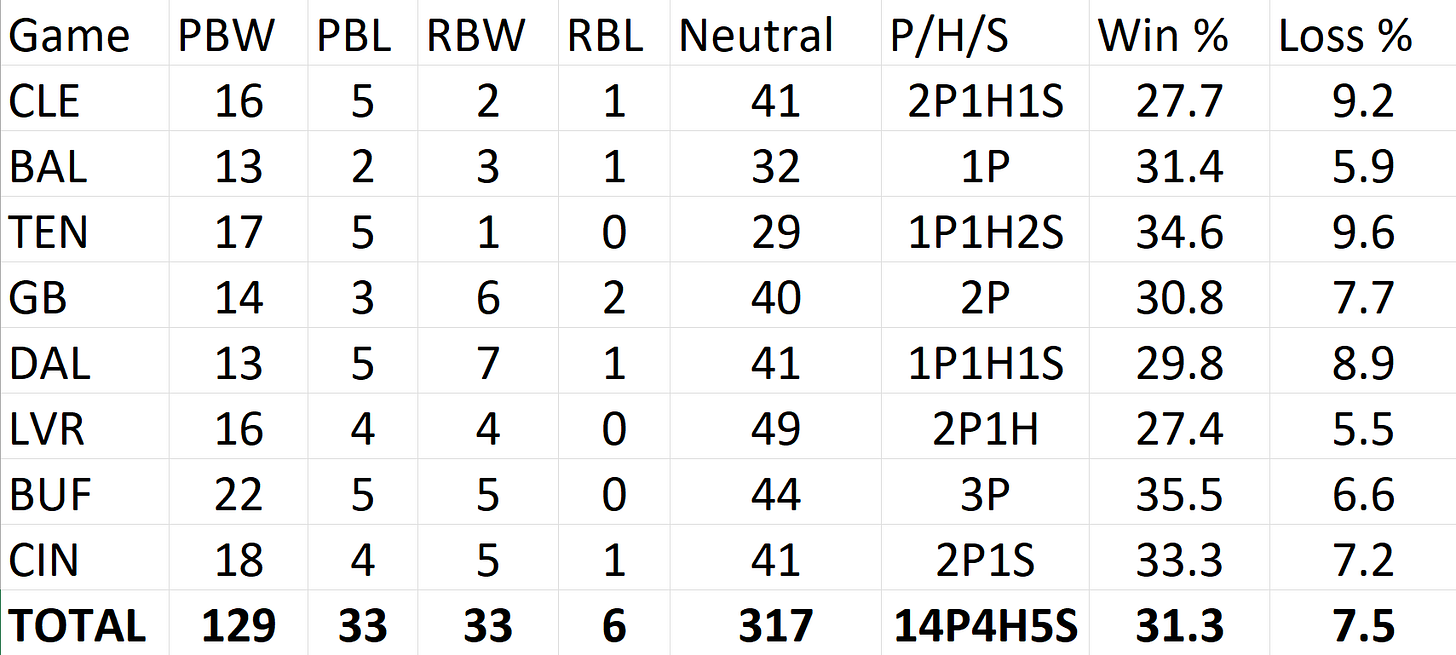

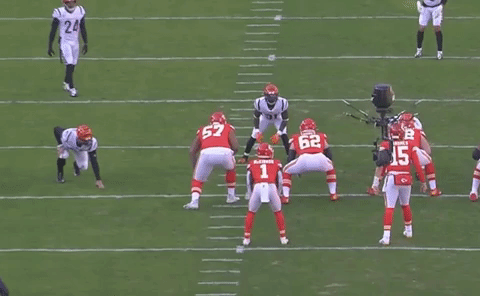


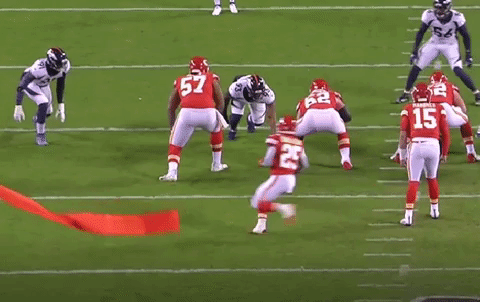
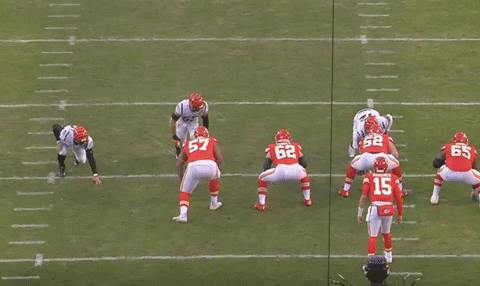
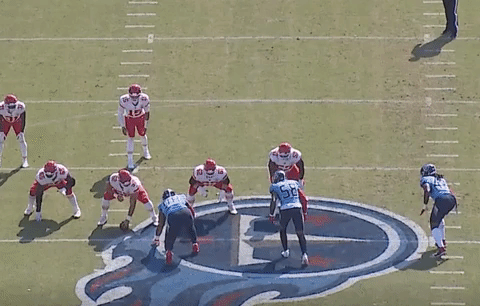


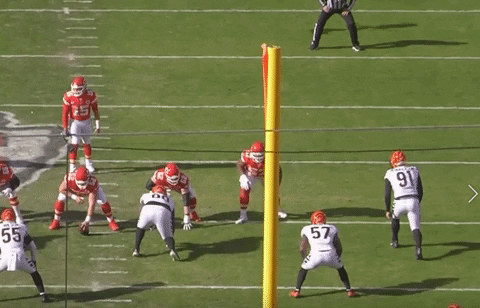
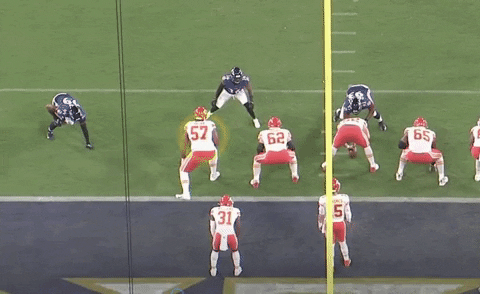
No TLDR here. I read the whole thing. I like your long articles with explanations and observations. Speaking of which I recognized something about why I thought Brown was struggling more than he actually did. You pointed out how we fans got used to watching Fisher and never really saw him chasing a defender at the top of the arc. See it all the time with OBJ. 💡 moment.
The subscribers over at KCSN were batting around Spotrac's contract prediction for OBJ of 5 years, $117 mil. I thought it was insane until I gamed out the numbers. He's clearly an above average left tackle. I would peg that value at about $18 mil next year. Add in 10% inflation per year to peg to the growing salary cap and here is his yearly breakdown - $18 mil, $19.8, $21.9, $24, $26.4 for a total of 5 years, $109.8 mil. Fans should be prepared for a big number but, in reality, it will probably be the correct evaluation of him as a player.